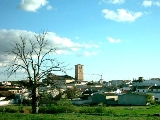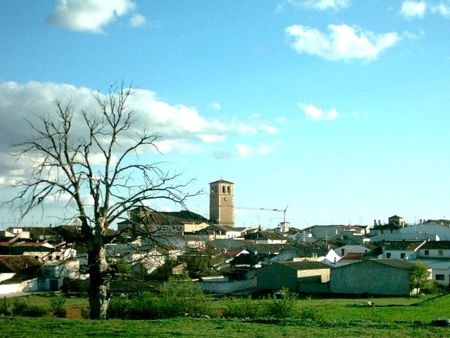
Campillo de Altobuey
Encyclopedia
Campillo de Altobuey is a municipality
in Cuenca
, Castile-La Mancha
, Spain
. It has a population of 1,691.

of Cuenca, it is also located half-way between Cuenca
(65 km.) and Albacete
(90 km.) and also between Madrid
(200 km.) and Valencia (135KM).
It is the typical village of Castile
, where stands out the high tower, visible from several km around.
Its climate is Mediterranean but extreme in Winter and Summer.
Cultivations of different products practices: cereals, vineyards, olive tree, lentils, garlic… Campillo always has been known by its saffron, and although its culture has diminished much, exists an enterprise initiative to commercialize it at national and even at international level. The Agricultural Cooperative San Andrés Apóstolcounts on around 800 partners. One is in charge to serve to the agriculturists (cereal distribution, seeds and installments) and also works as wine warehouse and oil mill.
It is limited to a textile factory that has avoided the emigration from many people to other places.
Municipality
A municipality is essentially an urban administrative division having corporate status and usually powers of self-government. It can also be used to mean the governing body of a municipality. A municipality is a general-purpose administrative subdivision, as opposed to a special-purpose district...
in Cuenca
Cuenca (province)
Cuenca is a province of central Spain, in the eastern part of the autonomous community of Castile-La Mancha.-Guide to the area:Located in a natural setting of beauty, the Old Town of Cuenca occupies a superb site between two river gorges. Famous are its 15th Century "hanging houses" , that appear...
, Castile-La Mancha
Castile-La Mancha
Castile-La Mancha is an autonomous community of Spain. Castile-La Mancha is bordered by Castile and León, Madrid, Aragon, Valencia, Murcia, Andalusia, and Extremadura. It is one of the most sparsely populated of Spain's autonomous communities...
, Spain
Spain
Spain , officially the Kingdom of Spain languages]] under the European Charter for Regional or Minority Languages. In each of these, Spain's official name is as follows:;;;;;;), is a country and member state of the European Union located in southwestern Europe on the Iberian Peninsula...
. It has a population of 1,691.

Situation
Located in the ManchuelaManchuela
Manchuela or La Manchuela is a comarca located in Castile-La Mancha, Spain.-Historical comarca:The historical Manchuela comarca included the municipalities of Tarazona de la Mancha and Villalgordo del Júcar, as well as the Requena-Utiel comarca which had been part of the Cuenca Province until 1851...
of Cuenca, it is also located half-way between Cuenca
Cuenca, Spain
-History:When the Iberian peninsula was part of the Roman Empire there were several important settlements in the province, such as Segóbriga, Ercávica and Gran Valeria...
(65 km.) and Albacete
Albacete
Albacete is a city and municipality in southeastern Spain, 258 km southeast of Madrid, the capital of the province of Albacete in the autonomous community of Castile-La Mancha. The municipality had a population of c. 169,700 in 2009....
(90 km.) and also between Madrid
Madrid
Madrid is the capital and largest city of Spain. The population of the city is roughly 3.3 million and the entire population of the Madrid metropolitan area is calculated to be 6.271 million. It is the third largest city in the European Union, after London and Berlin, and its metropolitan...
(200 km.) and Valencia (135KM).
It is the typical village of Castile
Castile (historical region)
A former kingdom, Castile gradually merged with its neighbours to become the Crown of Castile and later the Kingdom of Spain when united with the Crown of Aragon and the Kingdom of Navarre...
, where stands out the high tower, visible from several km around.
Its climate is Mediterranean but extreme in Winter and Summer.
Population
It reached four thousand inhabitants in the last centuries. From 1900 the population has dropped, especially in the 1960s and 1970s, as a result of emigration, mainly to Valencia.Interesting places
It is a municipality with a great cultural patrimony, in spite of his size:- The Parochial Church of San Andrés, located in the main seat, is a columnar temple, with three ships and plant of hall. Its construction dates from the 16th century16th centuryAs a means of recording the passage of time, the 16th century lasted from 1501 to 1600. It is regarded by historians as the century in which the rise of the West occurred....
, but in the 17th century17th centuryThe 17th century was the century which lasted from 1601 to 1700 in the Gregorian calendar.The 17th century falls into the Early Modern period of Europe and in that continent was characterized by the Dutch Golden Age, the Baroque cultural movement, the French Grand Siècle dominated by Louis XIV, the...
the valuable original caissoned ceiling with tube vaults was covered and it was constructed to a cupola in the cruise, decorated with rich paintings murals. Account with a tower of high altitude and five bodies.
- The old convent of San Agustín and present Sanctuary of the Virgin of the Hill is one of the best samples of the baroque one of the province of River basin. It was constructed at the beginning of the 18th century18th centuryThe 18th century lasted from 1701 to 1800 in the Gregorian calendar.During the 18th century, the Enlightenment culminated in the French and American revolutions. Philosophy and science increased in prominence. Philosophers were dreaming about a better age without the Christian fundamentalism of...
, with ship of Latin cross plant with lateral chapels, great cupola on the cruise, baroque altarpieces and abundant ornamentation of foliages in walls and vaults. In the place that occupied cloister of the convent, a Bullring was constructed after the confiscation, that comes using until the present time.
- The hermitage of the also well-known Trinidad as Eternal Father is located when coming out towards Motilla del PalancarMotilla del PalancarMotilla del Palancar is a municipality in Cuenca, Castile-La Mancha, Spain. It has a population of 5,224....
. It is of end of 16th century. The ship is covered by a Renaissance ceiling with paintings of Hernando de Mayorga.
- Hermitage of the Christ, is of sober a baroque one being remarkable the cover of the hermitage and the inner altarpiece. Adjacent is the old hospital, now dedicated to lodge the House of Culture.
- The existence of an old wind mill is remarkable in the environs.
- In addition to the monumental wealth, Campillo counts on zones of natural and landscaping interest as they are the pine of San Isidro or the hill of Santa Quiteria.
Economy
- Agriculture
Cultivations of different products practices: cereals, vineyards, olive tree, lentils, garlic… Campillo always has been known by its saffron, and although its culture has diminished much, exists an enterprise initiative to commercialize it at national and even at international level. The Agricultural Cooperative San Andrés Apóstolcounts on around 800 partners. One is in charge to serve to the agriculturists (cereal distribution, seeds and installments) and also works as wine warehouse and oil mill.
- Industry
It is limited to a textile factory that has avoided the emigration from many people to other places.
Celebrations
- From 7 to 14 September: Main holidays in honour to Virgin of the Loma
- 17 January: San AntónSan AntónSan Antón is one of the 31 barrios of the municipality of Ponce, Puerto Rico. Along with Canas Urbano, Machuelo Abajo, Magueyes Urbano, and Portugués Urbano, San Antón is one of the municipality's five originally rural barrios that are now also part of the urban zone of the city of Ponce. It is...
- 15 May: San IsidroIsidore the LaborerIsidore the Laborer, also known as Isidore the Farmer, , was a Spanish day laborer known for his goodness toward the poor and animals. He is the Catholic patron saint of farmers and of Madrid and of La Ceiba, Honduras....

